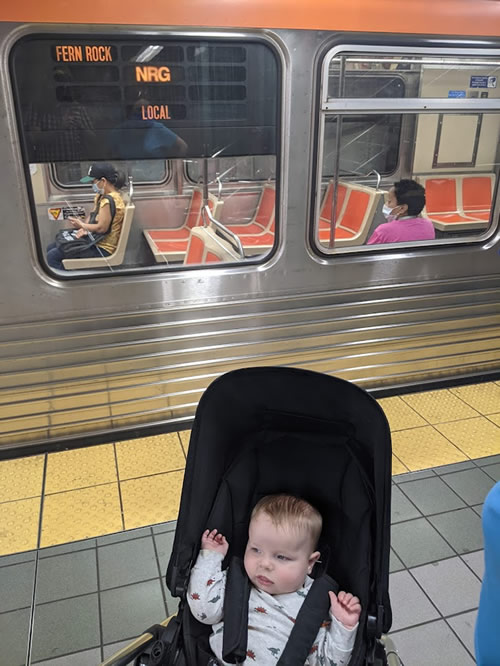
I have a new job, and have for the last forty days, helping faculty in Drexel’s School of Public Health write and submit their grants, keep their grant budgets straight, report on their research when it’s over. It’s rewarding and busy and combines the mission of a nonprofit with the institutional backing of a university, which may be the ideal blend to create a reasonable work/life balance. I’ve spent a lot of time thinking about the three-legged stool of trying to navigate the need for gainful employment in America: the precarious balance of doing (a) something that you love, (b) something that you’re uniquely good at, and (c) something that does good for other people and the world. I think Brandzy helped me develop this particular stool, though there are other potential crossbars, such as (d) making a reasonable amount to live on, (e) having enough time for a personal life, and (f) having enough energy for a creative life. I feel like this position may afford me the best opportunity since I worked at Glide to blend all six elements. Hearing an incredibly moving and passionate interview on public radio with a new Rabbi working at Glide since 2017 reminded me to wonder if I would still be working there had I never left the Bay Area.
That was the last time I had a train commute, when I walked half a mile to Downtown Berkeley BART, rode under the Bay to Powell Street Station in San Francisco, walked up another half-mile past the cable cars into the heart of the Tenderloin for three years in the second half of what some folks now call the aughts. That commute was one of my favorite parts of the job, and not just because it made me walk two miles a day, and not just because I got to grab a breakfast sandwich handmade every morning at my favorite hole-in-the-wall walk-up shop on the City side. The commute insisted that I spend time on two things I love doing but rarely make time for: reading and observing. These activities are, of course, at the heart of writing, which I would often do when I came home from the commute, about the commute itself. These stories are well catalogued in the “Strangers on a Train” category on this site, a tradition I hereby begin to continue today, three weeks overdue (check the title against the date of the post), with my new commute to my new employ.
In light of my past experience, I have overrated the joy of a train commute. Which is to say, more accurately, that not all train commutes are created equal. When in London a few Christmases back, I got to sample life with a portion dedicated to some combination of the Underground and the extended rail network, the one that empowers much of metro London to never even consider owning a motor vehicle. It was delightful, even when I almost got stranded in Kingsclere on a pilgrimage to Watership Down. The trains were plentiful, timely, and comfortable, and the culture of London is such that people expect to dedicate serious time and effort to reading paper editions of books. I’ve been impressed by the breadth and quality of independent bookshops supported by Philadelphia, no less after departing my second college town in the last three cities to not support a single true alternative to the university Barnes & Noble (not that I have a lot against Barnes & Noble). It remains unclear to me how many of them actually sustain their owners in any meaningful way, but then again any business worth running is best done as a public service to the community. I am currently being served to the tune of needing an eighth bookshelf (though one is full of board games) in my library/office to sustain the growing piles.
In any event, I have romanticized my Berkeley/SF commute as the norm for all potential subway or light rail routines. The last month on SEPTA has set the record somewhat straight. It’s not that I dislike the ride, the route, or the cars themselves, much less my fellow riders en masse. (This fact, notably, seems to make me unique in the entire city of Philadelphia, as complaining about SEPTA feels as ubiquitous a pastime as booing the local sports teams and people recoil in horror when I tell them that I happily board thrice weekly round-trips as though I have said, perhaps, that I am willingly sliding down a giant worm intestine to get to work.) But the ride is, if anything, too short. And it’s bifurcated by a slightly frantic transfer, splitting my five-stop ride into three and then two, which only underscores the shortness of the experience. It is probably bizarre to wish for a commute to take more of one’s time, but when the goal is building up enough momentum on reading to achieve relaxation and a near-Zen mindset entering (or more crucially, leaving) the workday, a mere five stops across two rides is not enough time. I find myself not infrequently grateful when one of my lines is running late and I am required to stand on the platform for many extra minutes enjoying, of late, Patchett’s prose.
It’s also hard to compare my SEPTA jaunts so far to any past regimen. We are, as a planet, nearly two years deep into a pandemic that has been consistently and often willfully bungled by the species it besets. The plague has slaughtered millions and continues to needlingly afflict the richest, most selfish, and most technologically coordinated country on the globe. The point of this post is not to explore the manifestations and causes of such self-inflicted exacerbation (truly, go read everything else published everywhere else in the last twenty months for such analysis) but the ways it impacts the SEPTA experience cannot be attributed to SEPTA alone. It is possible that BART and the T and even the Underground are similarly less comfortable in commensurate turns due to COVID-19 and its fallout; indeed, the prior experiences I had on SEPTA were remarkably joyous compared to my current half-weekly schlep. Most notably, the seats are deliberately left half-empty in a weaksauce attempt at social distancing that must be a hangover of the pre-vaccine prime-time of the pandemic when people took such measures seriously (and the trains must have been very empty indeed). This has the weird effect of seeming to reward the “manspreading” and other antisocial behaviors of a pre-’20s world, but also feels most illogical when the result is people standing in much closer facial proximity than they would if everyone occupied all the seats in the first place. This becomes particularly poignant when such proximity is held with any of the 25% of ridership that insists on baring their face, an uncanny portion of which seem to be sniffling and coughing at the time.
I don’t mean here to undercut what I said about still liking my commute. I like it, very much indeed. If I could read standing up in a train without getting a violent and almost immediate migraine, the stakes of who stands and who sits would be much lower, though the times I’ve had to stand have enabled me to spend time observing, which is less relaxing but almost as good. I can watch the kids on their way to or from charter schools, with preppy uniforms blotched by a single casual note of rebellion (untucked shirt, popped collar, unbuttoned sleeve) that may or may not be corrected at the campus door. I can watch exhausted medical personnel unwinding with a YouTube video, able to laugh for perhaps the first time today. I can watch the tired single mother disciplining her three small children as they invade their neighbors’ personal space, more curiosity and boredom than an effort to violate norms. I can watch the defiant well-dressed anti-maskers believing that cloth would mar the glint of their too-white teeth in the fluorescent glare of the rumbling traincar. I can watch the tattooed and pierced and all-black-adorned anarchists who dutifully pull their slipping masks over their noses as if to prove that no one really believes in nothing.
In shape and structure, SEPTA’s downtown run (I get on at Ellsworth-Federal after a mile walk from home, transfer from Broad the Market-Frankford at City Hall/15th Street, then debark at 34th Street to the miracle of Drexel’s campus) is most reminiscent of the labyrinthine stations of the Paris Metro. Several years ago, in twin trips sandwiched around Fish’s wedding, I pulled my trapezius lugging Alex’s and my heavy baggage across the elaborate stairways and passages of various Paris stations in an effort to successfully complete a route without leaving the fare gates. Similarly, my transfer at City Hall/15th requires two substantial sets of steps and a narrow corridor between them, something I learned the hard way when I first made the switch with a stroller-bound Graham in tow. But I’ve since settled in, not just because I have only a backpack and usually loose book to carry instead of a nine-month-old in his metal-framed conveyance. There is a muscle memory that develops in all commutes, no matter how easy or arduous. One memorizes the turns and twists, practices an alternative hallway or staircase, then settles in on the most efficient routine. After a few weeks, one learns to calibrate which car, even which doorway, is most efficient to aim for in ensuring a speedy transfer. If I walk up three doors on the first train in the morning, I will be perfectly placed at the foot of the steps to start transferring lines. Going left instead of right at the subsequent fork gives me a better chance to run to a waiting train if it’s there. On the return journey, I can cut a lot of hurried walking by leisurely walking four doors down before the train rumbles in.
Boarding and disembarking is the only stressful part of the operation, really. I imagine the whole thing could be a nightmare for those running late with a strict deadline, but my work’s schedule is looser in accordance with my exempt worker status. I would always rather get to work earlier or home earlier once I’m underway, but it’s not important enough for me to worry about. I am lucky this way, I know. But even for me, entering and leaving cars is made anxious by the eagerness with which the conductor wants to close the doors, with the unwillingness of a small but virulent quotient of riders to respect the order of letting people get off first, then getting on. There is also a strange prevailing assumption that no one in front of you on the train is also getting off, even at a very popular or transfer station, which creates a lot of unnecessary pseudo-jostling and bobbing and weaving as the train slows to a stop. Then in both directions, there is the inevitable squeezing between the almost universal twin sentinels posted at each door who are neither entering nor leaving, yet insist on remaining posted up in the doorway to narrow it by two-thirds.
I found this practice utterly inexplicable for the first month of ridership, both in its singular antisociality and total inconvenience to both the squeezed riders, but also (I would imagine) to the sentinels themselves, who must surely be more comfortable without people pushing past them at every stop for a lengthy ride. What I’ve only recently realized is that the doorways are the one place where a stander feels comfortable riding without placing their hands on a surface of the train – a bar, rail, post, or chair back – as they can lean against the flat metal panels that flank the doorways and maintain their balance. This appears to be the most coveted spot on the train, the veritable aisle seat of the front row, and ducking out of it for even a moment to let others egress more easily would simply mean sacrificing it to another opportunist who doesn’t mind narrowing and threshing the confluence of humanity that brushes past them. As someone who has stood behind a person taking up too much width of a grocery store aisle for literally five minutes rather than saying “excuse me” to get them to move and allow me to pass, I simply cannot relate to this behavior, but I have observed it too consistently to find another explanation. Of course, I also have never shied away from touching a handrail on a bus or train. Even in the midst of a seemingly interminable pandemic, I can’t find the requisite germophobia anywhere in me to resist relying on these metal surfaces. At this point, surface-based spread of coronavirus seems pretty thoroughly debunked, and outside a pandemic, I tend to be the person most likely to eat something off the floor, to not be grossed out or disgusted by most any average occurrence. (Much was once made of my disinclination to be “sippy,” to share drinks or food with friends, but it was always a mistake to conflate this with a feeling about germs. It’s much more about my aversion to food and feeling weird about a certain sense of intimacy implied in such sharing.) Still, after years of BART ridership, it remains baffling to watch a clot of riders crowd into a car and then just park themselves as close to the doors as possible rather than disperse to the interior of the car, especially when most of them are staying aboard for several stops.
The stations themselves are like American subway stations everywhere: overlit by low-hanging bare fluorescent bulbs, floored and walled at acute angles with layers of grime and decay, corners decked with buskers, off-label salesmen, and the disheveled starving, the occasional railing or metal flourish seeming to date from 18-something. Ad posters on every surface not easily accessible by human hands, with SEPTA advertising and maps where people can reach. In the corridors between City Hall and 15th Street, they are advertising a renaming convention for SEPTA lines that they feel will make things less confusing, citing apparent complaints that people often board the wrong line or a train going in the wrong direction. This must periodically happen, but only to periodic visitors, those who have not even had a handful of weeks to internalize a bodily route, turn here, duck down this staircase, run in this short burst in case the train is there but you can’t see it, post up on this pillar. Humans are pattern-seeking creatures, they can make a routine out of anything, they seek to make the novel automatic. I am enjoying this process as it unfolds, the inculcation of direction and route, the commitment to memory of certain shapes and turns and tactics. It is the way we use our generally safe urban society to simulate complicated practices of maintaining survival in a bygone generation. It takes pausing a moment to see the masks, to hear the sneezes, to see the hangdog faces and hear the sighs to realize that life and death are still in play in our orange-seated rolling environment. It is less fatal to be here, surely, than on the wreck-riddled highways and intersections of the surface where beancounters long ago accepted breathtaking risk percentages, but it cannot be called perfectly safe. Capitalism asks us to risk our lives, whether we like our work or not, whether we like how we get there or don’t. It is little wonder that jobs are turning over so quickly, like so many trains discharging their passengers to climb the stairs and disperse into the night.


